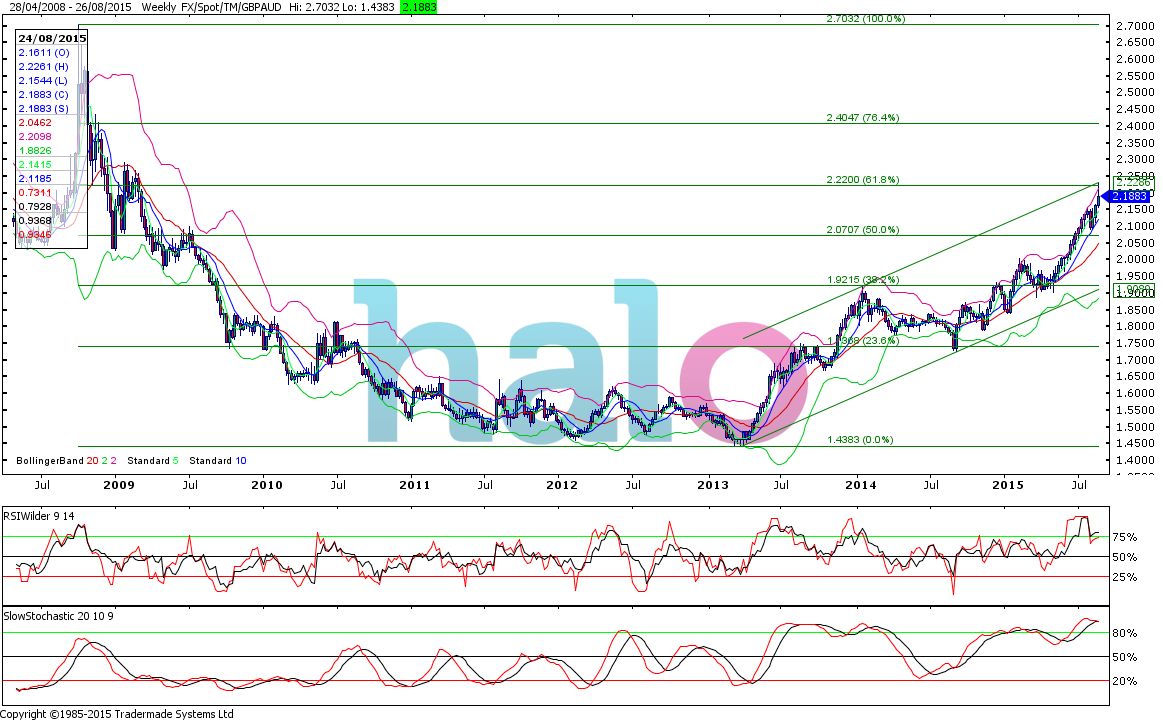Australian Dollar Research Report
Sterling Australian Dollar (GBPAUD) FX Technical Analysis
In a month where the RBA left interest rates on hold and the majority of Aussie data surprised to the upside, we have seen GBPAUD accelerate within the uptrend of the last couple of years.
UK data has been a bit of mixed bag over recent weeks, with UK inflation suggesting the Bank of England will raise rates sooner rather than later but UK retail sales failing to support this.
The main focus for the market has actually been events in China. With Chinese stock markets continuing to fall, the Chinese government re-valuing their currency and the PBoC (People’s Bank of China) cutting both the reserve requirements and headline interest rates fears over the outlook for the world’s 2nd economy have continue to grow.
As risk sentiment has taken a knock, we have seen US stock markets have their largest 4 day losing streak in history over the course of this week.
This financial market turmoil has spilled over into the currency markets and we have seen the Aussie sold accordingly. As Australia and China are such heavy trading partners a downturn in the outlook for China has a big impact for Australia. As a rule of thumb, commodity currencies (Aussie, Kiwi, Rand and CAD) tend to weaken when risk aversion increases.
Technically, GBPAUD remains within the long term uptrend that has been in place since hitting the 1.4383 lows in April 2013. This uptrend looks set to continue, although a short term correction cannot be ruled out as the move this week has been so aggressive. With a move to the 10 week moving average (2.1187) possible. This has underpinned the market since April so should continue to do so. Personally, I would suggest any correction is likely to run out of steam in the 2.15 region but only a move below 2.02 would suggest the uptrend has run its course.
As long as the market remains above 2.15 short term, then we should see a move higher. Of course the million dollar question is; where to trade? Realistically the next long term level of resistance is in the 2.22 region, as this coincides with the 61.8% Fibonacci level from the 2.7032-1.4383 move then I would suggest this makes a good target. It is worth putting this in context as rates of this nature are the best we have been able to offer since early 2009 i.e. more than a 6 year high.
Buyers:
As mentioned above, the trend is in your favour. Initially, targeting a rate in the 2.20 region seems sensible given the levels of resistance in the 2.22 region. If you have time on your side, you may wish to employ a price averaging strategy i.e. breaking your requirement down into smaller transactions and trading as the market moves.
Sellers:
Unfortunately, the trend remains firmly against you. As the old saying goes “let the trend be your friend”. In this case the market is moving away from you, so trading sooner rather than later seems the sensible strategy. We’re seeing a bit of a pull back from the highs at this stage, so it would be worth seeing how this correction plays out. It is worth noting that an uptrend is defined as series of higher peaks and higher lows, this is a pattern that remains intact, so I would expect 2.15 to be the limit of this correction and a move back above 2.22 would suggest the correction has been completed and the uptrend is resuming.
Trading foreign exchange on margin carries a high level of risk, and may not be suitable for all investors. The high degree of leverage can work against you as well as for you. Before deciding to invest in foreign exchange you should carefully consider your investment objectives, level of experience, and risk appetite. The possibility exists that you could sustain a loss of some or all of your initial investment and therefore you should not invest money that you cannot afford to lose. You should be aware of all the risks associated with foreign exchange trading, and seek advice from an independent financial advisor if you have any doubts.
Recommended Content
Editors’ Picks
EUR/USD edges lower toward 1.0700 post-US PCE

EUR/USD stays under modest bearish pressure but manages to hold above 1.0700 in the American session on Friday. The US Dollar (USD) gathers strength against its rivals after the stronger-than-forecast PCE inflation data, not allowing the pair to gain traction.
GBP/USD retreats to 1.2500 on renewed USD strength

GBP/USD lost its traction and turned negative on the day near 1.2500. Following the stronger-than-expected PCE inflation readings from the US, the USD stays resilient and makes it difficult for the pair to gather recovery momentum.
Gold struggles to hold above $2,350 following US inflation

Gold turned south and declined toward $2,340, erasing a large portion of its daily gains, as the USD benefited from PCE inflation data. The benchmark 10-year US yield, however, stays in negative territory and helps XAU/USD limit its losses.
Bitcoin Weekly Forecast: BTC’s next breakout could propel it to $80,000 Premium

Bitcoin’s recent price consolidation could be nearing its end as technical indicators and on-chain metrics suggest a potential upward breakout. However, this move would not be straightforward and could punish impatient investors.
Week ahead – Hawkish risk as Fed and NFP on tap, Eurozone data eyed too

Fed meets on Wednesday as US inflation stays elevated. Will Friday’s jobs report bring relief or more angst for the markets? Eurozone flash GDP and CPI numbers in focus for the Euro.
